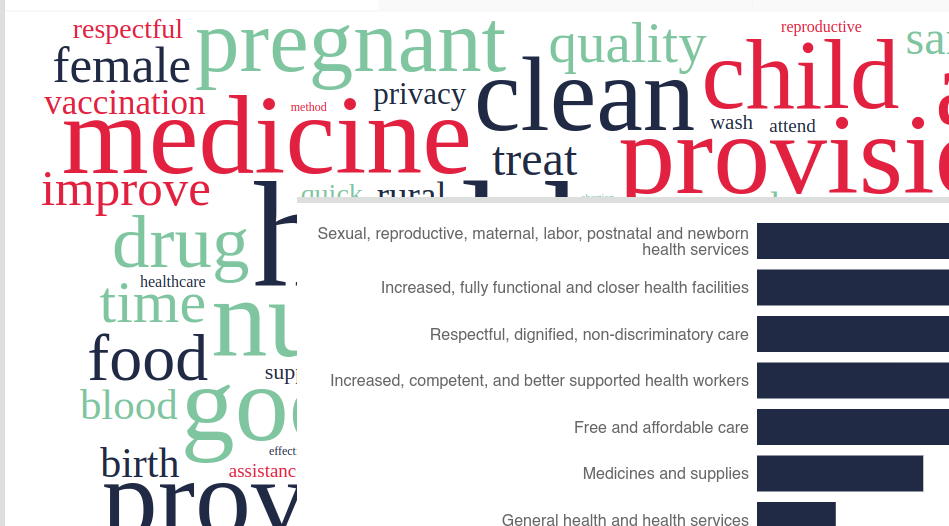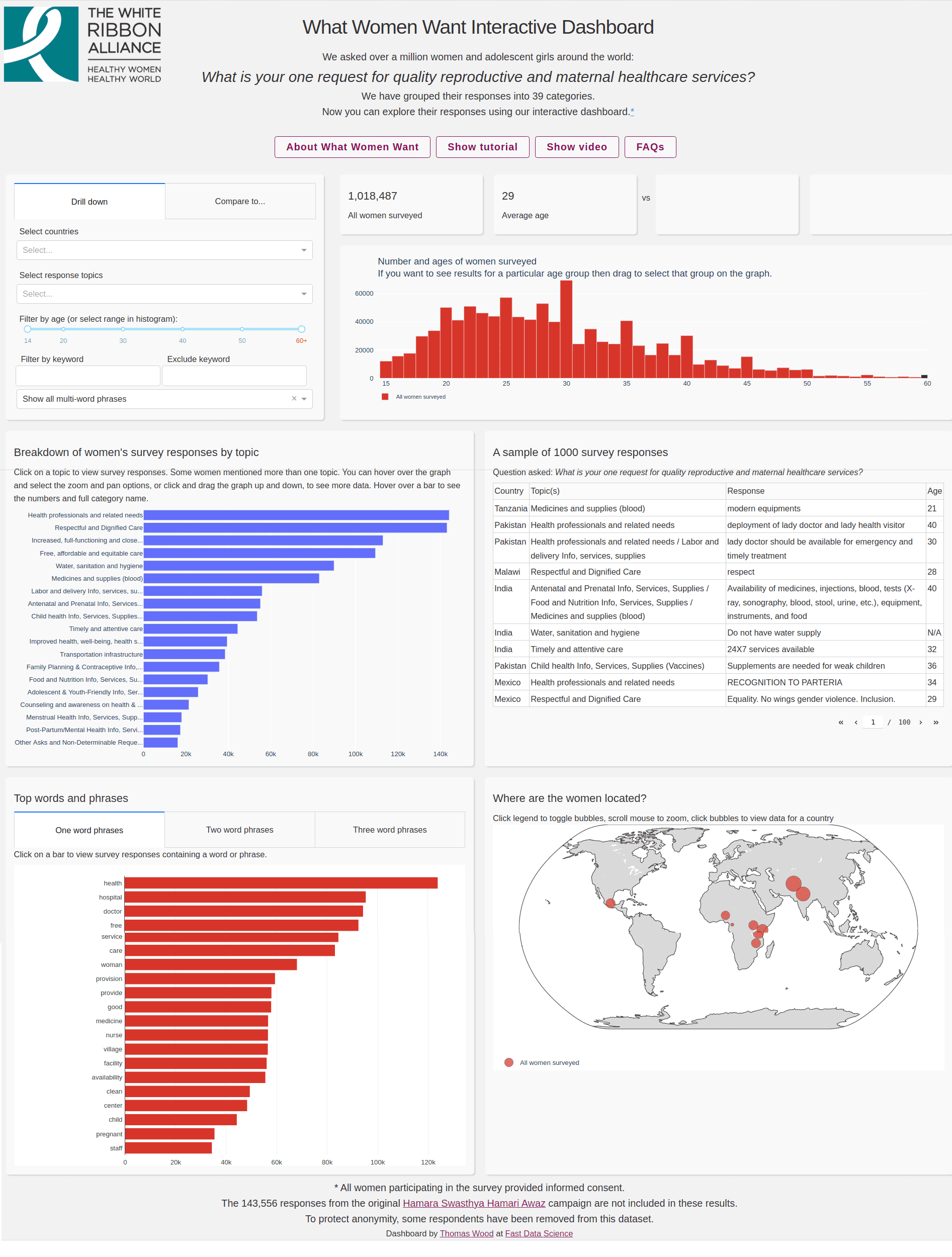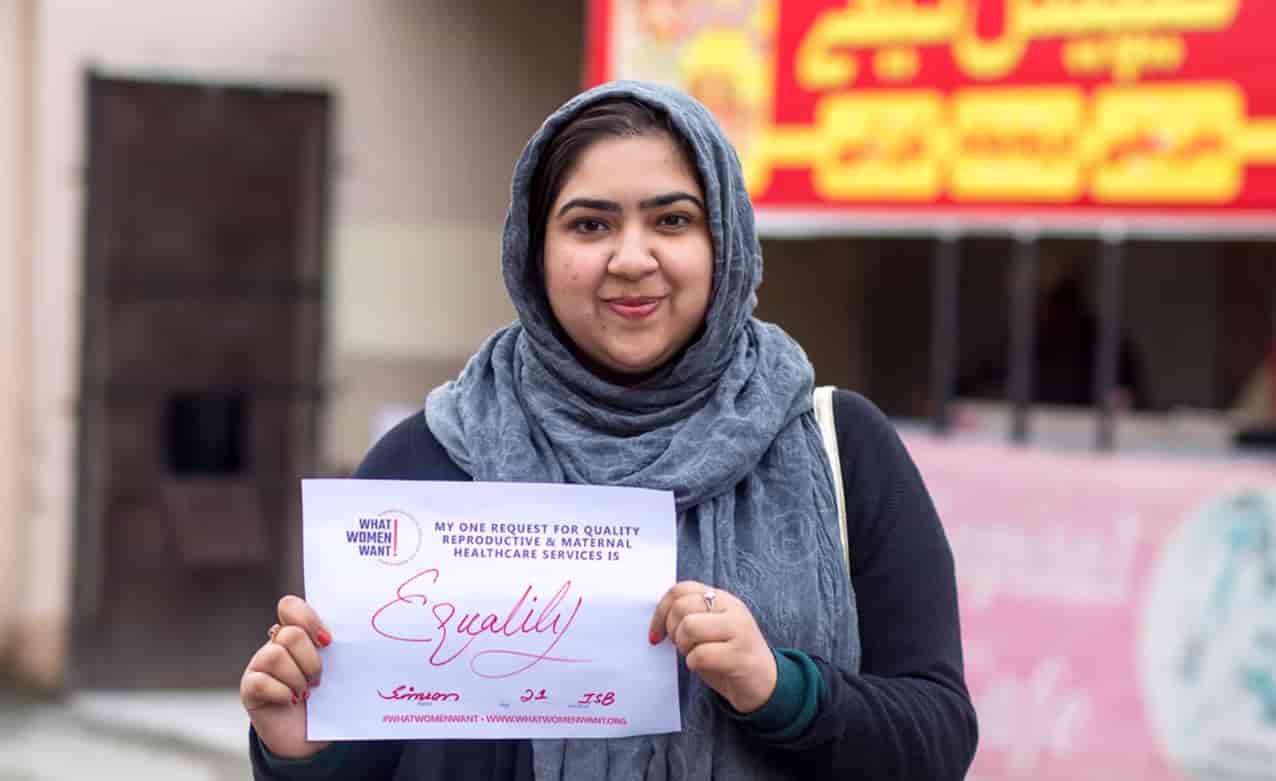
How can natural language processing and data science help non-profits (charities) such as the White Ribbon Alliance analyse survey data and share it with the world? We have developed an interactive dashboard allowing members of the public to explore women’s healthcare requests around this world. We believe this is a first for transparency in the third sector. Click here to view the dashboard that Fast Data Science developed for the White Ribbon Alliance.

Screenshot of What Women Want NLP Dashboard
Hundreds of thousands of businesses and organisations conduct surveys each year for a variety of purposes. Some of them are conducted by marketing experts wanting to get into the minds of their target audience and better understand their buying behaviour. At the same time, non-profits and charities are designing surveys focussing on issues such as mental health, women’s healthcare needs, or hygiene. The type of survey you should be conducting depends entirely on your business model and your requirements.
The advantage of surveys is that they provide businesses and non-profits with data that they can tap into to meet their needs and extract value. But conducting a survey isn’t always sunshine and rainbows.
Not only do businesses need to make sure that the surveys they are conducting are perfectly designed right from the get-go and collect every single piece of information they want to get their hands on, but they also have to spend countless hours analysing the data.
Broadly speaking, survey data can either be in a numerical or text format. Analysing numerical data isn’t that big of a deal. The problem lies with analysing text data.
Video about the What Women Want survey, by US-based non-profit White Ribbon Alliance. We have used data science and natural language processing to analyse the survey responses.Data scientists can divide text data into two kinds:

Example of a closed-ended multiple-choice question in a survey. The user must choose one of the options.

Example of an open-ended question in a survey, where the respondent can reply in free text.
The responses to closed-ended questions are easy to code and quantifiable. But that’s not the case with the open-ended questions.
Open-ended questions are designed for gathering meaningful answers, helping businesses create rich and qualitative data, especially where it’s not possible to think of all the possible responses in advance. A respondent can reply to an open-ended question entirely in their own words.
Responses to open-ended questions are super-hard to code and analyse and can be done in the following three ways:
The downsides of traditional survey analysis techniques are that they are not only time consuming and requires businesses to allocate a huge amount of manpower, but they are also subject to inaccurate data analysis.
Fast Data Science - London
Let’s talk about the What Women Want survey, which was conducted by the American non-profit White Ribbon Alliance (WRA) and gathered responses from millions of women all across the world. In addition to this, we’ll also be talking about the challenges involved in analysing this volume of text data.
Before we begin, let’s know a bit more about the organisation and the work it does.

The women in the What Women Want campaign responded by writing their healthcare requests in their own language, in their own words. The ultimate open-ended survey question!
The White Ribbon Alliance is one of the best-known American non-profit organisations working towards advancing women and girls’ reproductive and general health and rights. The organisation is highly focused on addressing the issue of women dying during childbirth and pregnancy.
Recently, they conducted their What Women Want survey, which recorded responses from over a million women globally and was highly focused on learning what kind of health services women actually need the most
The WRA and its partner organisations asked over a million women and adolescent girls around the world,
What is your top request for your maternal and reproductive healthcare?
Women from countries such as Mexico, India, Malawi, Kenya, Pakistan, Uganda, Nigeria, and Tanzania recorded their responses, and you may take a look at the findings right here.
While conducting such a large-scale survey was itself a huge undertaking, it was also extremely difficult to analyse the data collected.
Because the question was open-ended, the responses were in text form. So, WRA faced a hard time analysing all of it using traditional survey data analytics techniques. In addition to this, some respondents recorded their responses in their native languages which had to be translated to English. About 70% of the overall responses were painstakingly hand-coded by a specially trained team.
The survey responses that couldn’t be hand-coded were auto-tagged using various machine learning and NLP models, such as the Bidirectional Encoders Representations from Transformers (BERT) model.
Using cutting-edge machine learning techniques, our experts at Fast Data Science were able to clean the data and automatically categorise the remaining uncoded survey responses into different topics, such as Water, Hygiene, and Sanitation. Click here to head over to our Dashboard which uses Natural Language Processing and Machine learning, allowing the WRA staff, policymakers and general public to quickly and easily analyse the campaign’s data from all across the world.
Literally, anyone anywhere can have access to this huge amount of data and easily analyse it without needing to be an expert statistician.
Let’s dive deep into the practical aspects of our Dashboard.
Once you visit the Dashboard, you will be greeted with a quick tutorial, which will show you around and familiarise you with its features.
With the Drill Down vs Compare To options, you can easily compare two groups or segments of respondents, in our case the girls and women who responded to the survey.
For example, you can find out how the responses of Cameroonian women differed from the Indian ones.
Here’s our Drill Down section:

The filters control view of the What Women Want dashboard.
And here’s our Compare to section:

The ‘Compare to’ filters control view of the What Women Want dashboard.
We compared how the responses of Cameroonian women differed from those of Indian women on the topic “Environmental health and agricultural support” and here are the results:

The What Women Want data science dashboard can be set to compare Cameroonian vs Indian women who mentioned a certain topic, allowing the user to drill down to a high level of granularity.

The NLP dashboard allows you to see subsets of the raw survey responses and the ages and locations of those women.

The dashboard also allows a drill down into one-, two- and three-word phrases (trigrams) as well as a map view of the respondents’ locations.
Let’s break down the Drill Down and Compare to sections even more:
Let’s set our Drill Down options as follows:
Here’s what the results look like:

You can look at a brief comparison between the women who were surveyed by the non-profit in India, Malawi, Nigeria, and India between the age range 30-50 on the topics you have selected vs all the women who were surveyed. In addition to this, the graph is super-detailed helping you pinpoint exactly what you want.
It’ll leave you stunned.

In addition to this, on the left-hand side, you can take a look at the survey responses by clicking on the topic. On the right side, you can view the actual responses.

On the left-hand side, you can view the survey responses containing a word or a phrase and set it to “One-word phrases,” “Two-word phrases” and “Three-word phrases” depending on your requirements.
On the right-hand side, one can view the world map and toggle bubbles, zoom in and view data for that specific country.
Sounds impressive, doesn’t it?
In that case, allow me to introduce you to the world of Data Science, and how Data Science and Natural Language Processing can revolutionise the work of non-profits.
“The problem isn’t finding data. It’s about figuring out what exactly to do with it.”
Mike Loukides, O’Reilly Media
Organisations can have a world of unstructured data and not know what to do with it. And that’s exactly where we come in.
At Fast Data Science, we harness the power of AI to help you with your ventures. Right from the beginning, our experts will provide you with highly-professional data science consulting services for your business. What’s our biggest strength is that we keep up with the latest trends and are able to respond to various challenges with our heads held high. With us, you won’t feel like you are talking to another one of those non-technical sales representatives. Each one of us is a professional data scientist using AI for the greater good.
Need help analysing that humongous survey? Want a technically-advanced dashboard like the one we created for WRA? It’s time you got in touch with us immediately. Our experts will schedule a meeting with you and would love to know more about your survey and dive deep into it. In addition to this, we’ll be providing you with our world-class data science consulting services to turn the process highly-efficient. And once we have everything on the plate, we will work our magic and create a highly-responsive dashboard for your campaigns.
So, it’s time to sit back and say goodbye to your data analysis problems straight away.
All you need to do is get in touch with us, and we’ll be glad to assist.
Unleash the potential of your NLP projects with the right talent. Post your job with us and attract candidates who are as passionate about natural language processing.
Hire NLP Experts
Thomas Wood presents the Clinical Trial Risk Tool before the November meeting of the Clinical AI Interest Group at Alan Turing Institute The Clinical AI Interest group is a community of health professionals from a broad range of backgrounds with an interest in Clinical AI, organised by the Alan Turing Institute.

Fast Data Science will appear at Ireland’s Expert Witness Conference on 20 May 2026 in Dublin On 20 May 2026, La Touche Training is running the Expert Witness Conference 2026, at the Radisson Blu Hotel, Golden Lane, Dublin 8, Ireland. This is a full-day event combining practical workshops and interactive sessions, aimed at expert witnesses and legal professionals who want to enhance their expertise. The agenda covers critical topics like recent developments in case law, guidance on report writing, and techniques for handling cross-examination.

Guest post by Alex Nikic In the past few years, Generative AI technology has advanced rapidly, and businesses are increasingly adopting it for a variety of tasks. While GenAI excels at tasks such as document summarisation, question answering, and content generation, it lacks the ability to provide reliable forecasts for future events. GenAI models are not designed for forecasting, and along with the tendancy to hallucinate information, the output of these models should not be trusted when planning key business decisions. For more details, a previous article on our blog explores in-depth the trade-offs of GenAI vs Traditional Machine Learning approaches.
What we can do for you